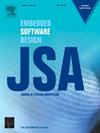Dynamic task offloading and resource allocation for energy-harvesting end–edge–cloud computing systems
IF 4.1
2区 计算机科学
Q1 COMPUTER SCIENCE, HARDWARE & ARCHITECTURE
引用次数: 0
Abstract
In end–edge–cloud (EEC) computing, end devices (EDs) offload compute-intensive tasks to nearby edge servers or the cloud server to alleviate processing burdens and enable a flexible computing architecture. However, resource constraints and dynamic environments pose significant challenges for EEC task offloading and resource allocation, including real-time requirements, unreliable task execution, and limited battery energy, especially in energy harvesting (EH) systems, in which battery energy remains unstable due to its inherent fluctuations. Existing task offloading and resource allocation approaches often fail to address these challenges holistically, leading to degraded performance and potential task execution failures. In this paper, we propose a novel task offloading and resource allocation method for EH EEC computing, aiming to optimize long-term performance by minimizing delay and energy consumption while ensuring task execution reliability and battery energy stability. Specifically, we formulate task offloading and resource allocation as a cost optimization problem under constraints such as ED capacity, task reliability, and energy consumption. To solve this problem, we first leverage Lyapunov optimization to decouple the original time-dependent problem. Then we derive optimal closed-form solutions for computation and transmission power resource allocation. Based on these solutions, we propose a multiple discrete particle swarm optimization algorithm to determine task offloading decision. Extensive experiments demonstrate the superiority of our method in balancing delay, execution reliability, and energy stability under varying conditions.
能量收集端缘云计算系统的动态任务卸载和资源分配
在EEC (end - edge - cloud)计算中,终端设备将计算密集型任务卸载到附近的边缘服务器或云服务器上,以减轻处理负担,实现灵活的计算架构。然而,资源约束和动态环境给EEC任务卸载和资源分配带来了重大挑战,包括实时性要求、不可靠的任务执行和有限的电池能量,特别是在能量收集(EH)系统中,电池能量由于其固有的波动而保持不稳定。现有的任务卸载和资源分配方法往往不能从整体上解决这些挑战,从而导致性能下降和潜在的任务执行失败。在本文中,我们提出了一种新的EH EEC计算任务卸载和资源分配方法,旨在通过最小化延迟和能量消耗来优化长期性能,同时保证任务执行可靠性和电池能量稳定性。具体来说,我们将任务卸载和资源分配表述为ED容量、任务可靠性和能耗约束下的成本优化问题。为了解决这个问题,我们首先利用Lyapunov优化来解耦原始的时间相关问题。然后给出了计算和传输功率资源分配的最优封闭解。在此基础上,提出了一种多离散粒子群优化算法来确定任务卸载决策。大量的实验证明了我们的方法在不同条件下平衡延迟、执行可靠性和能量稳定性方面的优越性。
本文章由计算机程序翻译,如有差异,请以英文原文为准。
求助全文
约1分钟内获得全文
求助全文
来源期刊

Journal of Systems Architecture
工程技术-计算机:硬件
CiteScore
8.70
自引率
15.60%
发文量
226
审稿时长
46 days
期刊介绍:
The Journal of Systems Architecture: Embedded Software Design (JSA) is a journal covering all design and architectural aspects related to embedded systems and software. It ranges from the microarchitecture level via the system software level up to the application-specific architecture level. Aspects such as real-time systems, operating systems, FPGA programming, programming languages, communications (limited to analysis and the software stack), mobile systems, parallel and distributed architectures as well as additional subjects in the computer and system architecture area will fall within the scope of this journal. Technology will not be a main focus, but its use and relevance to particular designs will be. Case studies are welcome but must contribute more than just a design for a particular piece of software.
Design automation of such systems including methodologies, techniques and tools for their design as well as novel designs of software components fall within the scope of this journal. Novel applications that use embedded systems are also central in this journal. While hardware is not a part of this journal hardware/software co-design methods that consider interplay between software and hardware components with and emphasis on software are also relevant here.
 求助内容:
求助内容: 应助结果提醒方式:
应助结果提醒方式:


